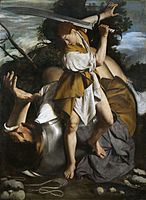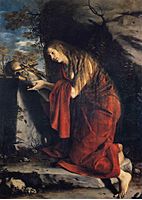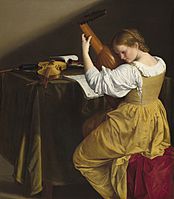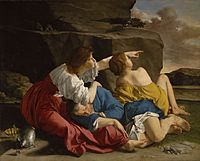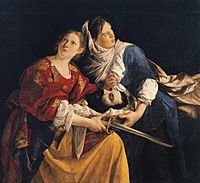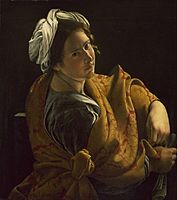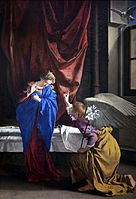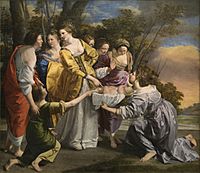Orazio Gentileschi facts for kids
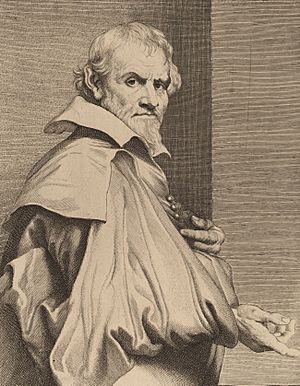
Orazio Lomi Gentileschi (born 1563, died 1639) was a famous Italian painter. He was born in Tuscany and started his art career in Rome. At first, he painted in a style called Mannerism, often adding figures to the decorative art of other artists.
After the year 1600, his painting style changed. He was influenced by the more natural and realistic art of Caravaggio. Orazio received important painting jobs in Fabriano and Genoa. Later, he moved to Paris to work for Queen Mother Marie de Medici. He spent the last years of his life in England, working for King Charles I of England, and he passed away in London. Orazio Gentileschi was also the father of another well-known painter, Artemisia Gentileschi.
Contents
Orazio's Early Life and Art
Orazio Gentileschi was born in Tuscany, Italy. His father, Giovanni Battista Lomi, was a goldsmith from Florence. Orazio was baptized in Pisa on July 9, 1563. He later took the name Gentileschi from an uncle he lived with after moving to Rome. This move happened sometime between 1576 and 1578.
Working with Other Artists in Rome
When Orazio first started working in Rome, he often painted with other artists. For example, he painted the people in the landscapes created by Agostino Tassi at the Palazzo Rospigliosi. He might have also painted figures in the great hall of the Quirinal Palace. However, some experts think another artist, Giovanni Lanfranco, painted those. Orazio also worked on paintings in several churches, including Santa Maria Maggiore, San Nicola in Carcere, Santa Maria della Pace, and San Giovanni in Laterano.
How Caravaggio Changed Orazio's Style
Around 1600, Orazio's painting style changed a lot. This was because he met and was influenced by Caravaggio, who was younger than him and also working in Rome.
Orazio learned from Caravaggio's way of painting directly from real people. This helped him make his art look more lifelike. For example, a 73-year-old man named Giovanni Molli posed for some of Orazio's paintings around 1610–11, including a full-body painting of St Jerome. Orazio even used studies of Molli's head, made years earlier, for the head of Abraham in his painting Sacrifice of Isaac in the 1620s.
After Caravaggio left Rome, Orazio developed his own unique style. His paintings became known for lighter colors and very precise details. This style reminded people a bit of his earlier Mannerist work.
In 1611, Orazio worked with Agostino Tassi again on projects like the decorations at the Casino delle Muse. However, they stopped working together due to a disagreement.
Between about 1613 and 1619, Orazio painted many works for people in the Roman Marches region, especially in the cities of Ancona and Fabriano.
Moving to Genoa
In 1621, Orazio Gentileschi moved to Genoa. He was invited by Giovanni Antonio Sauli, who had previously asked Orazio's brother, Aurelio Lomi, to paint for him. In Genoa, Orazio painted works for Sauli, including a Magdalene, a Danäe, and Lot and his Daughters.
He also found other people who wanted his art in Genoa. One of them was Marcantonio Doria. For Doria, Orazio created many frescoes (wall paintings) showing stories from the Old Testament. These were in a special building (now destroyed) on the grounds of Doria's palace in Sampierdarena.
Working in France and England
In the summer or autumn of 1624, Orazio left Genoa and traveled to Paris. There, he worked for the Queen Mother, Marie de Medici. He stayed in France for two years. Only one painting from this time has been clearly identified: an allegorical painting called Public Felicity. This painting was made for the Palais du Luxembourg and is now in the Louvre museum.
In 1626, Orazio, along with his three sons, left France for England. He became part of the household of George Villiers, 1st Duke of Buckingham, who was the King's most important minister. Orazio stayed in England for the rest of his life.
One of his first big projects in England was a large ceiling painting (which no longer exists) of Apollo and the Muses. This was for Buckingham's newly rebuilt home in London, York House, located in the Strand. Even before Buckingham's death in 1628, Orazio had started receiving support from the royal family. After Buckingham passed away, all of Orazio's painting jobs came directly from the King's family.
Queen Henrietta Maria especially liked Orazio's art. He painted the beautiful ceilings at Queen's House in Greenwich. These paintings were later moved to Marlborough House in London. The paintings Orazio made during his time in England are often more elegant and refined than his earlier works.
These English paintings include two versions of The Finding of Moses, both from 1633. One of these was sent to Philip IV of Spain. People used to think King Charles I sent it as a gift, but now we know Orazio sent it on his own.
While Orazio was in England, the famous artist Anthony van Dyck drew a portrait of him. This drawing was meant for van Dyck's Iconographia, which was a collection of portraits of important artists, leaders, collectors, and scholars of that time. Van Dyck planned to publish these as engravings.
Orazio Gentileschi died in London in February 1639. He was buried in the Queen's Chapel at Somerset House.
Works
- Orazio Gentileschi
See also
 In Spanish: Orazio Gentileschi para niños
In Spanish: Orazio Gentileschi para niños




